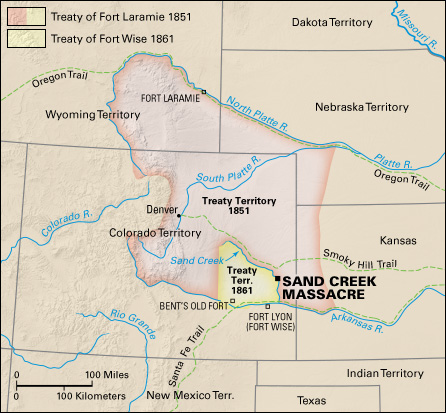Sand Creek Massacre was an 1864 incident in which American militia (citizen soldiers) killed hundreds of peaceful Cheyenne and Arapaho. The massacre took place on the banks of Sand Creek in what is now southeastern Colorado. The incident is sometimes called the Chivington massacre, after the soldiers’ leader, Colonel John Chivington.
Background.
During the mid-1860’s, Native Americans and white settlers often clashed on the western frontier. The settlers normally relied on army soldiers for protection from the people on whose land they were settling. However, at that time many regular soldiers were busy with the American Civil War (1861-1865).
In June 1864, Colorado Territory Governor John Evans warned the “friendly Indians of the plains” that the United States was warring against hostile Native American groups. Evans ordered all Cheyenne and Arapaho to report to Fort Lyon, in southeastern Colorado. He promised that the fort would protect them.
On September 28, a group of Cheyenne and Arapaho chiefs traveled to Camp Weld, near Denver. They were led by the Cheyenne chief Black Kettle. The group met with Governor Evans, Colonel Chivington, and other government representatives. Black Kettle told Evans, “All we ask is that we may have peace with the whites.” Black Kettle was told to establish his camp at Sand Creek, about 40 miles (64 kilometers) north of Fort Lyon. Black Kettle’s camp consisted of mostly Cheyenne people, along with some Arapaho.

Evans had earlier organized a regiment to protect the territory’s white settlers from hostile Native Americans. Chivington, the regiment’s commander, had repeatedly said he was eager to fight any Native American. In early November, Major Scott Anthony, one of Chivington’s officers, became the commander at Fort Lyon. Anthony replaced an officer who had been considered too friendly with the Native Americans.
The massacre.
On November 29, Chivington and about 700 American militia arrived at Sand Creek. At the time, about 500 Cheyenne and Arapaho people, mostly women and children, were there. Most of the warriors were away hunting buffalo. Black Kettle, who displayed an American flag and a white flag of truce, told his people that the soldiers would not hurt them.
To make it difficult for the Cheyenne and Arapaho to escape, the American militia drove off their horses. Chivington then positioned his men and four cannons around the camp. Some officers, including Captain Silas Soule, protested that the camp had been promised safety. Nonetheless, Chivington’s cannons opened fire.
The Native Americans scattered, and Chivington’s men charged. Black Kettle and many other people escaped, but a few warriors fought back. Most experts believe that the soldiers killed between 150 and 300 people in the camp. Many of those killed were women and children. The soldiers mutilated many of the dead bodies.
Nine American soldiers were killed and 38 wounded. Many of them had been accidentally shot by their own men.
Aftermath.
The Sand Creek Massacre dashed any hopes for peace that had remained among some Cheyenne and Arapaho. Many Cheyenne and other Native American groups attacked white settlers in retaliation.
News of the attack at Sand Creek was celebrated by many in Denver. However, other Americans were horrified by the news. The U.S. Joint Committee on the Conduct of War investigated the incident. The committee’s report concluded that Chivington had “planned and executed a foul and dastardly massacre.”
Chivington and Evans were forced to resign their positions. Soule was killed in Denver not long after he testified against Chivington at a military commission. Many historians believe the murder was carried out by a person loyal to Chivington. In 1868, Black Kettle was killed in a battle on the Washita River near present-day Cheyenne, Oklahoma.
